A week after white supremacists and neo-fascists made a violent show of force in Charlottesville, Virginia, far-right forces were set to rally on the Boston Common on August 19, 2017. The rally, planned weeks earlier, had been permitted by the city. It fell apart after less than an hour. Surrounded by 25,000 to 40,000 counter-protesters, a small group of white supremacists—along with a few enablers claiming to be libertarian Republicans—had to be escorted off the Common by the police.
In the belief that the massive Boston counter-protest may hold lessons for confronting the far right today, Bill Keach asked activists who helped organize and participate in the event to contribute their reflections. The article ends with a list of relevant texts and photo sources, including the original Facebook announcement posted by Black Lives Matter Network and their allies calling for a “Fight Supremacy! Boston Counter-Protest & Resistance Rally”:
We believe those committed to anti-racism work have a moral obligation to unapologetically confront and oppose these violent and threatening displays [by white supremacists] when they occur…[Nevertheless, t]he individuals and institutions most effective in harming Black and Brown people do not carry torches or wear white hoods. Instead, they aggressively patrol our neighborhoods, enforce laws unequally, systematically impose poverty, and suppress the voices and needs of oppressed communities. This supremacy is upheld by all who benefit from it and is in alignment with capitalism, cis-hetero patriarchy, ableism, queer and trans antagonism, misogynoir, and all existing forms of oppression.
We envision a future where Black and Brown families are no longer torn apart due to systemic white supremacy.
Thanks to Dana Morgensteen for supplying the text of this announcement.
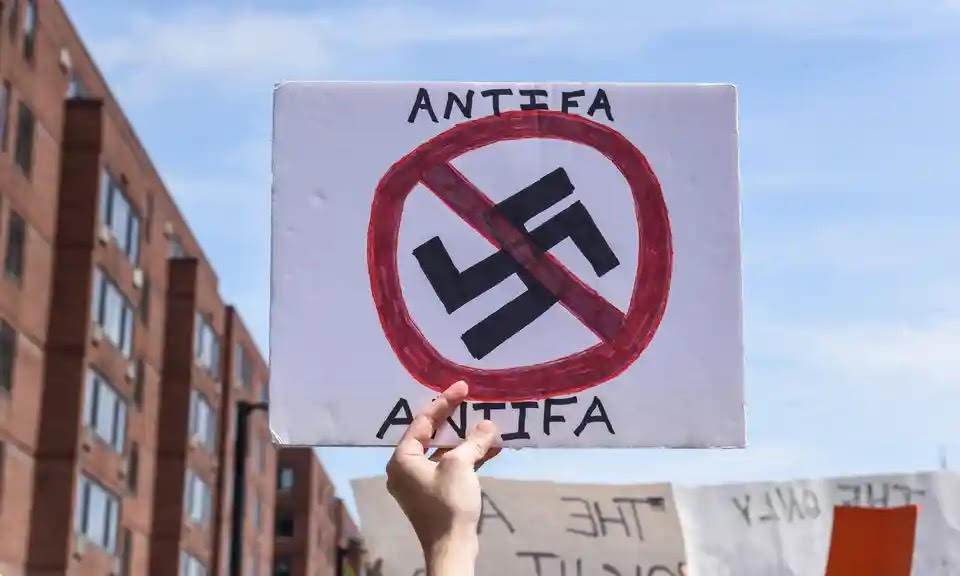
Bill Keach
is a member of the Tempest Collective, Boston Revolutionary Socialists, and Boston DSA.
The far-right rally in Boston on August 19, 2017 had been billed by organizers as a “Free Speech Rally.” But when word spread that Proud Boys leaders Gavin McInnes, Joe Biggs, and Kyle Chapman had been invited to speak—one week after a neo-Nazi murdered Heather Heyer in Charlottesville, Virginia—anger and determination spread with it.
Boston Mayor Marty Walsh, now the new U.S. Secretary of Labor, approved the far right’s permit to rally on the Common, but warned that the police would deal harshly with any violent behavior. When it became clear that a big counter-demonstration was developing, Walsh extended his warning to “all sides” and he was careful not to encourage a militant anti-fascist turnout.
On the morning of Saturday, August 19, anti-fascist protesters gathered for the “Fight Supremacy Resistance Rally” near Roxbury Crossing, in one of the most important predominantly Black neighborhoods of Boston. The thousands gathered in front of the speaker platform first heard representatives from the local Indigenous community affirm their determination to march against the white nationalists. These speakers were followed by powerful statements from two rally organizers, Monica Cannon-Grant and DiDi Delgado of Black Lives Matter Network.
The last speaker, revolutionary socialist Khury Petersen-Smith, electrified the crowd explaining why ordinary people were determined to stand together against violent bigots who felt confident mobilizing openly because they had friends in the White House. The speech ended with these words: “What we know is that resistance is not something you say, it’s something you do!” The crowd roared in agreement. Mayor Walsh, who was standing near the platform but was not asked to speak, had a worried scowl on his face.
Some 15,000 protesters joined the two-mile march from Roxbury to the Common, a 50-acre green space in the center of Boston right across from the Massachusetts State House. Black Lives Matter led a large continent wearing T-shirts and carrying banners saying “Fight Supremacy!” A 500-strong socialist contingent included members of Democratic Socialists of America (DSA), the International Socialist Organization, Industrial Workers of the World, the Boston Socialist Party, and other groups on the organized Left. Many members of the Massachusetts Teachers Association—largest union in the state—were on the march, along with other organized workers.
As the march moved from Malcolm X Boulevard down Columbus Avenue towards the Common, in sweltering heat, protesters chanted “Get Up! Get Down! Anti-fascists Run This Town!,” “No Trump! No KKK! No fascists USA!,” and “Hey, Hey! Ho, Ho! Nazi Scum Has Got to Go!” Many onlookers applauded and showed their support from the sidewalks and from the windows of their apartments. Quite a few joined the march.
When the march reached the Common it was stopped by police, who had surrounded the bandstand where the far-right rally was already winding down with a double ring of crowd-control barriers. Heavily armed cops stood just behind the outer ring. Outside that ring were some 10,000 additional protesters from a separate rally in front of the Massachusetts State House called by Boston DSA and the Party for Socialism and Liberation (PSL).
As the larger group of marchers from Roxbury made their way onto the Common, the two anti-fascist demonstrations merged. Together they formed a huge ring of chanting protesters around the small group of far-right advocates lingering around the bandstand—without any of the big-name bigots they had invited to speak. Anticipation of a massive anti-fascist counter-protest had clearly undermined the bogus “Free Speech” show before it could even get off the ground.
Soon after the two counter-protests converged, the police began escorting participants in the far-right event through the huge circle of chanting and taunting counter-protesters and away from the Common. During that process a few scuffles broke out. Some among the counter-protesters taunted the police, threw bottles of urine and other objects at them, and tried to block police vans carrying the “free speech” organizers away. As police vans left the area, helicopters hovered overhead. Counter-protesters booed the cops and chanted “Who Do You Serve?!” By the end of the afternoon more than 30 counter-protesters had been arrested. Efforts were initiated by other counter-protesters to collect funds to help those arrested make bail.
Some of those escorted by police from the Common bandstand through the throng of counter-protesters insisted that they were members of a “Boston Free Speech Coalition.” They said that a “media frenzy” led to the perception that their event had been taken over by fascists and white nationalists. But at least two participants in the so-called “Free Speech Rally” had marched with the far right in Charlottesville the week before. Others behaved in ways that made their far-right allegiances obvious.
The significance of the large, loud, diverse counter-protest against the white nationalists was summed up in a Facebook post the following day by Amy Gaidis, who had traveled to Boston from Portland, Maine:
Yesterday was a victory for our side not just because we scattered and demoralized the white supremacists, but because tens of thousands of people went through the experience of standing confidently in their convictions in face of real fear. To win a better world, one free of white supremacy, oppression, and exploitation, we will need to go through experiences like yesterday again and again, on a larger scale. Boston was a victory that drew us a little bit closer. Today I don’t feel fear. I feel the pride and hope that comes from solidarity in mass action!
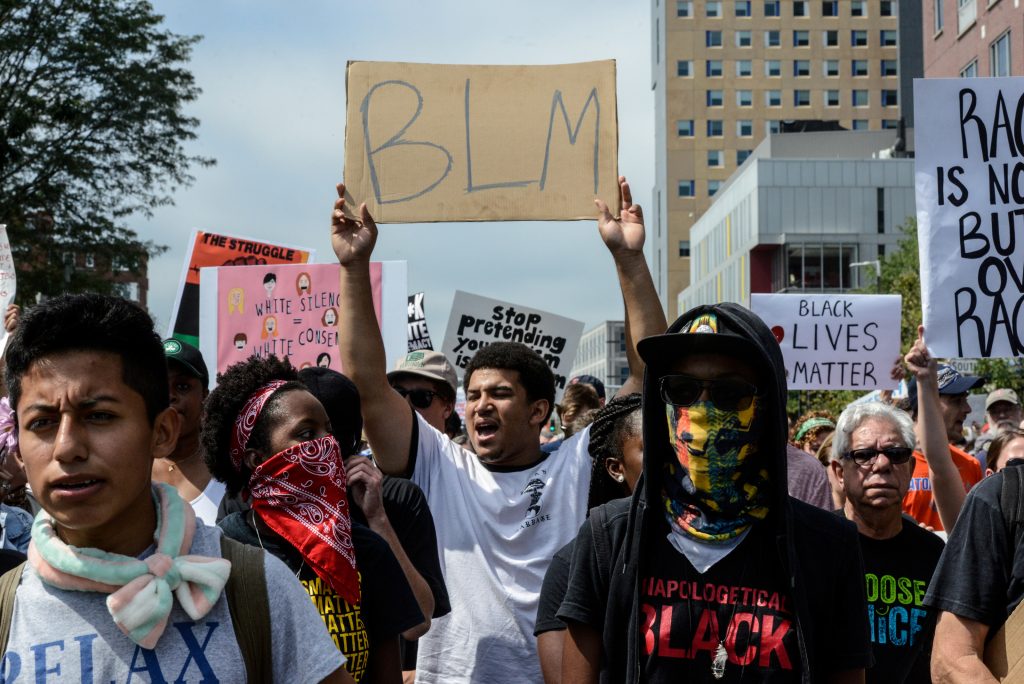
Khury Petersen-Smith
is a researcher, activist, and socialist who lives in Boston.
What I remember the most about the fight against the far right in August 2017 is how quickly a tide can turn. The days leading up to the action were ones of rising fear and horror. So many of us were shattered by the attack in Charlottesville. And then an antisemite smashed the glass in the beautiful, towering New England Holocaust Memorial downtown. Tension mounted as we approached the day of the fascist rally and our march against it.
But the tension was not solely defined by fear. I remember a rising determination among comrades and people throughout the city as that Saturday approached. I remember going to Family Hardware, a Black Caribbean-owned store in Dorchester, hoping to find some poles to carry a banner for the march. When one of the owners asked me what the poles were for, hoping to better help me find what I was looking for, I told her that I was working with organizers to make a banner for the anti-fascist march on Saturday. She nodded.
“Hold on,” she told me, and walked into a back room.
She returned with two poles of a perfect length and width, and made of reinforced cardboard—great for stapling fabric to!
“Take them,” she said with a nod, handing me the poles for free.
It was a roller coaster ride of feelings as the march grew closer. Inspiring moments, like at the hardware store, and then much heavier ones. I had more than one tearful conversation on the eve of the action as friends and comrades felt compelled to participate but soberly confronted the possibility of being hurt, or worse.
This was especially true for people of color and other marginalized folks, for whom the far right on the march is a deeply rooted nightmare come true.
But the greatest emotional shifts came the day of the march. What I felt personally and what I saw in the faces of the thousands gathering at Roxbury Crossing was fear evaporating from our bodies as the sense of our collective power swelled.
That sense ballooned as we pushed off and headed downtown, rising into a euphoria. Our numbers, our movement forward, the chants—all of these elements fed each other. As we marched through Roxbury and the South End, Black and Brown neighbors gathered on their stoops and extended their bodies out of third and fourth story windows, waving and cheering on the march. Puerto Rican and Dominican flags fluttering in the wind from those same apartment building windows served as more reminders of who the fascists were demonstrating against—and who we were marching with, the tributaries from around the world that feed our city, and the richness that we were defending.
The feeling was electric, and it was a challenge not to get caught up in it. But organizers had a job to do, not only keeping up the energy by leading chants, but scouting the landscape for fascists and cops in order to secure the march. After all, when actions are attacked, it is often once our side feels like the fight is over and lowers its guard. But as we marched on, it became clearer: we were winning.
Even before we got to the Boston Common, we knew that we had won. The fascists had vacated—with assistance from the police—well before the socialist contingent had arrived. We marched into the park for a victory lap.
Too often as activists, we assume that those of us who are already organized are the only ones who will show up when it is time to take action for justice. But the week leading up to the protest—and the march itself—confirmed the very opposite. When invited to contribute to the fight against one of our most dangerous enemies, ordinary people—some organized and the overwhelming majority not—defied well-founded, justified fear and rose. Whether contributing materials to march, joining the rally to send the march off, cheering it from the sidewalk, or participating in it, tens of thousands were part of the story of the victory that day. It is important for organizers to think expansively and offer multiple ways to participate; marching against the fascists is crucial to defeating them, but not all anti-fascists can march. We are challenged to open space for everyone who feels compelled to contribute.
I have been preoccupied these days with the role that the state played on August 19. Or rather, the role that it didn’t play. The city government was largely absent. The police too had a minimal presence on the march—mobilizing instead for the Common, where they protected the fascists. Far from sitting back in hopes that the state would defend us, August 19 was the people of Boston mobilizing to defend ourselves and each other.
After the January 6 attack on the U.S. Capitol, the state put 25,000 soldiers on the streets of Washington, D.C. Lawmakers are moving to pass legislation that is supposedly meant to stop the far right. More repression will not save us. The lasting victory of August 19, on the other hand, shows what is possible when ordinary people mobilize to become actors in our own history.
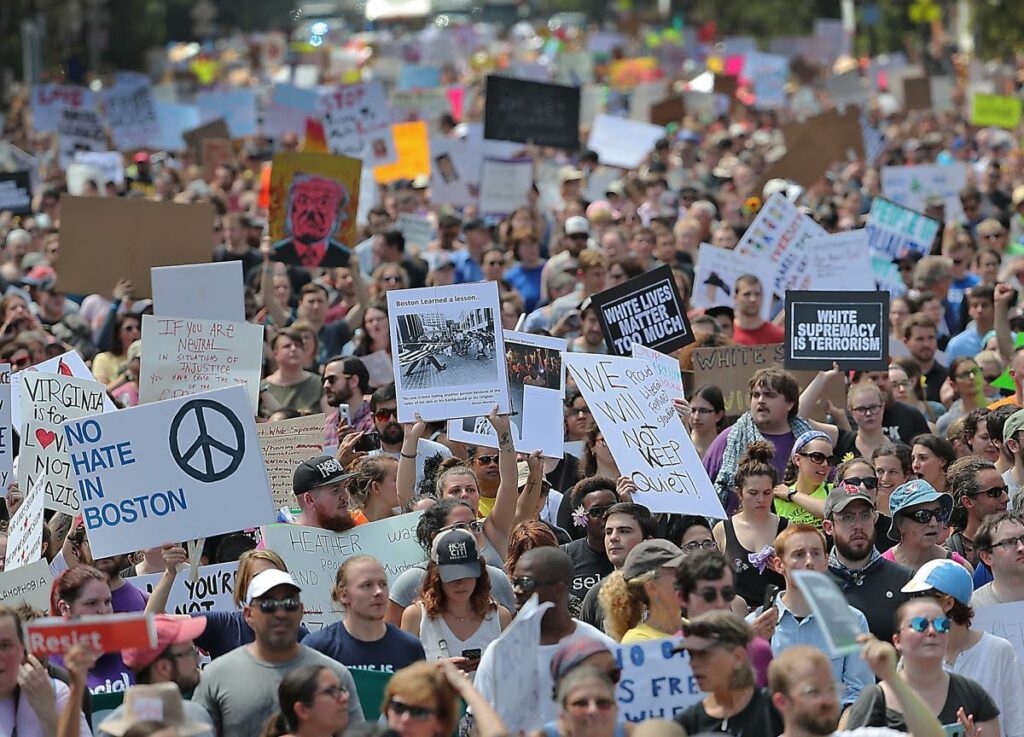
Peter Berard
is a member of Boston DSA.
In the months leading up to the “Boston Free Speech” rally, the Boston Left was badly divided regarding strategy when it came to dealing with fascists. We had not known what we were doing when we counter-protested against these same people in May, 2017, and confusion led to bad blood on our side.
Then the news came from Charlottesville. What a day that was. A friend of mine called for a standout on Boston Common. A few hundred of us showed up as the sun set. No bickering, no sectarianism, a few speeches, but mostly just us being together, feeling stunned and angry. Most importantly, we felt ready.
The day of August 19, I committed to helping a DSA and PSL-led rally near the State House steps. The crowd grew and then started to gravitate towards the Common bandstand where the fascists were and where people—a lot of people—were massing to tell them to go home. Truth be told, I saw few fascists that day. There was none of the bravado they displayed in May, despite all the elaborate security the Boston Police Department laid out for them.
Then you could hear the march coming, the big “Fight Supremacy March” from Roxbury. I only saw the images later, the sea of people moving down Boylston Street, and the socialist bloc marching shoulder to shoulder. Not long after that the word went around—the cops were evacuating the fascists. Special buses for their special friends. Cheering, hugging, laughing. Then back across the river for the afterparty.
It is cliché but true—that day turned the tide. The alt-right momentum from the 2016 election, locally and nationally, hit a brick wall. Our morale soared. Theirs plummeted. And we socialists learned to work together.
That said, we cannot rely on atrocities and massive media coverage to get tens of thousands of people on the street every time some chud throws a rally. We cannot rely on autonomous self-organization, or on the groups we always hope will turn out—from single-issue groups to unions—to come when we call. Resist Marxism, an organizational project of alt-right brawler Kyle “Based Stickman” Chapman, called another Boston-area fascist action in November 2017. We still outnumbered them, but because of bad communications and other strategic errors, there was no replicating August 2017. Consistently countering the fascists—and only consistency, not one big blow, can do it—takes grinding, day-in-day-out work. But the big blows surely help.
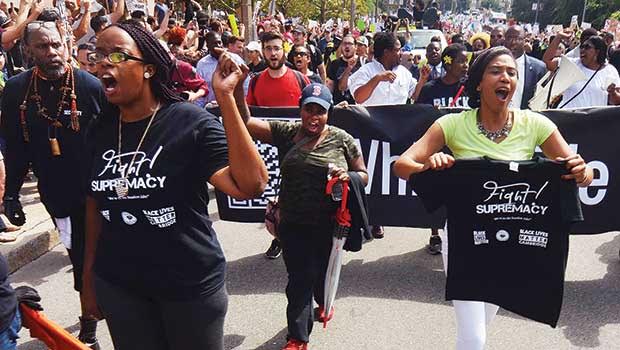
Alpana Mehta
is a socialist and activist in Boston.
The January 6 attempted takeover of the U.S. Capitol building was an alarming advance for far-right forces. Prior to that, the last massive nationally organized show of force by neo-Nazi and far-right groups was at the August 2017 “Unite the Right” rally in Charlottesville. On Janaury 6, far-right forces did not just include fringe elements seeking to seize an opening created by Trump’s election victory and recruit through a terror campaign of tiki-torch marches and individual acts of violence. This time, the far right had four years of open encouragement from President Trump and at least three months of preparation—not just by moneyed Trump supporters, but by fascist forces like the Proud Boys and Oath Keepers.
Although ultimately unsuccessful, the January 6 Capitol takeover was a collective experience by organized forces on the far right—something that had not occured yet on a national scale. Unlike the response in 2017 to the “Unite the Right” rallies and murder of Heather Heyer, there were too few organized responses by anti-racists. The broader sentiment was to look to the FBI and other so-called law enforcement agencies to arrest far-right “terrorists.” But the FBI and other police forces, which are not neutral in any way, have no real interest in suppressing organized racism and bigotry.
This makes it all the more important now to draw on recent memories of occasions when fascist forces were crippled. In August 2017, tens of thousands of counter-protesters descended on an attempted neo-Nazi rally and drove its participants out of town. The residents of Boston and surrounding cities defied the “stay home” orders of Mayor Marty Walsh and the Boston Police Departments and took our city back from the bigots.
The counter-protest had been organized for weeks—even before our comrade Heather Heyer was killed. Billed by the racists as a rally for free speech, August 19 in Boston was planned to be part of a series of coordinated events to “Unite the Right” in solidarity with Charlottesville. The organized far right had been buoyed by its success in Boston the previous May when they had outnumbered our side. Anti-racist activists and organizers began a campaign to publicize the openly fascist elements behind “Unite the Right.” Our side had recent experience in ongoing Black Lives Matter protests in Boston, in the Women’s March of January 2017, and in a massive protest of 30,000 against Trump’s Muslim ban that same month.
By the time August 2017 came around there were even more organizations in Boston actively engaged in street protests. Nonprofits that had oriented mainly towards service, and unions that had not always endorsed political protests, became part of a new core that mobilized together. Then came two factors that sealed the fate of the neo-Nazi rally on August 19. The first was the coming together of mainly Black activists and organizers largely based in Boston’s Roxbury neighborhood. They called a protest that was unequivocal in its position—a counter-protest to “Fight Supremacy.” Organizers pulled out every stop mounting a public effort to promote the rally, with press conferences, interviews, and outreach not just to anti-racist organizations in Massachusetts, but to Black Lives Matter activists around the country. The second factor, unclear in its scope to us organizers at the time, was the murder of Heather Heyer on August 12.
These two factors changed the political landscape. Other organizations, including one that I was part of, the International Socialist Organization, organized multiple public meetings on a daily basis. Some of these events were co-organized with groups like DSA and Socialist Alternative. Others were political meetings calling for people to organize and turn out on August 19. We printed thousands of flyers and hung them up on every conceivable surface. Walgreens employees, grocery store workers—all allowed the posting of flyers where none were allowed before. And unions began to endorse our rally. The Massachusetts Teachers Association endorsed the counter-protest, along with the Boston Public Libraries Professional Staff Association.
The far-right event looked more and more pitiful the closer we got to August 19. Speaker after speaker dropped out, citing “security concerns.” On the day of their so-called “Free Speech Rally” they were met by some 20,000 counter-protesters streaming out of subway stations, buses, and cars to march with “Fight Supremacy.” The “Fight Supremacy” march started nearly two miles away from the far-right rally on the Common, unclear about what awaited us but growing in size as we marched and chanted on. Our own socialist contingent grew from about 150 to 500. The closer we got to the Common, the more it felt like we were a wave about to sweep the garbage out to sea.
But we did not anticipate that we had become a tsunami. The “Fight Supremacy” march joined another 10,000 counter-protesters in the Common. None of us expected the thousands upon thousands of Boston residents, whom we had not met yet and had not organized with but who woke up that morning wanting to confront the far right. They had heard the news for weeks, they had listened to Mayor Walsh tell them to stay home, and they decided that Nazis would not be allowed in our city. They came straight to the far-right rally site—getting as close as we were allowed to get by the hundreds of cops—chanting, taunting, in some cases chasing the Nazis away.
This level or organizing can and should be possible whenever the far right calls an event. It was the months of experience and protesting and organizing prior to that amazing, boiling-hot day in August that pushed neo-Nazi forces onto the back foot. But if we do not continue to confront them, their attack on January 6 could turn out to be their most successful recruitment tool to date.
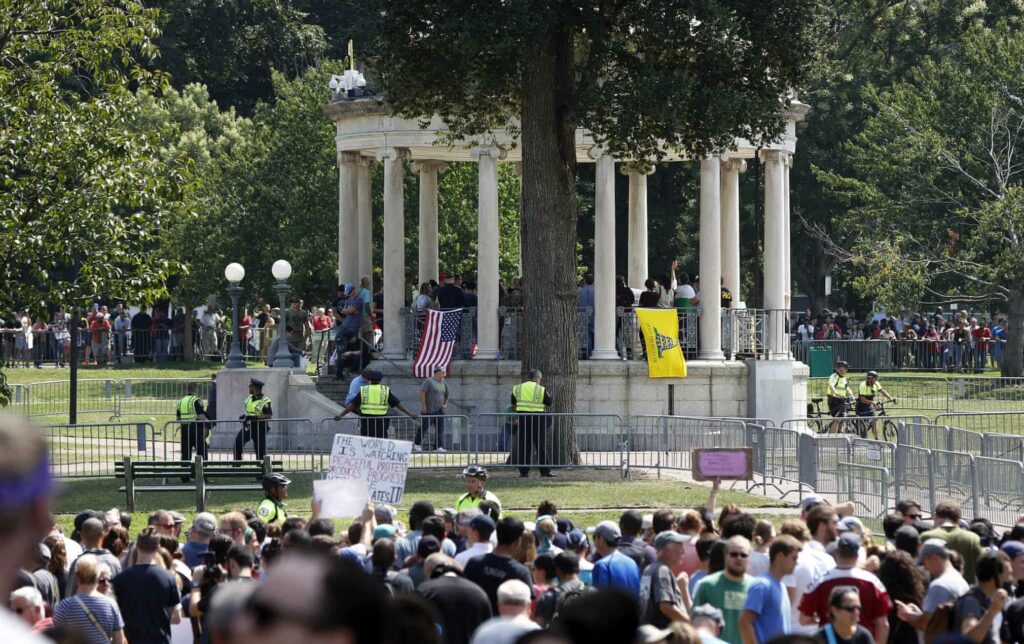
Michael Fiorentino
is a member of Boston DSA.
The 2017 “Unite the Right” rally in Charlottesville was a brutal reminder that the far right was gaining confidence and organizational coherence. They were attempting to showcase their ability to hold public rallies in cities around the United States, and they were finding real success. It was an alarming political development. Counter-protesters were largely drawn from the ranks of the radical left and its immediate periphery of supporters. While hundreds of thousands of people had attended Women’s Marches, and tens of thousands had mobilized to airports in defiance of Trump’s xenophobic travel ban, there was not yet a wide appreciation for the threat posed by the far right.
The “Unite the Right” rally changed that. Trump’s infamous “very fine people” comment was a wake-up call for a lot of people—the nascent alt-right had the tacit support of the president. It was becoming clear that a human wave was intending to turn out on August 19, and that is exactly what happened.
As inspiring and tangible a victory as it was, I think it is a mistake to hold up August 2017 in Boston as the template for anti-fascist organizing. Trump’s comments had inflamed millions of people, and it just so happened that the next far-right mobilization on the calendar was set for Boston. Thousands of people showed up independently of the organized Left; this is not necessarily a bad thing, but it can lead to an overestimation of our strength. It can obscure the importance of decidedly non-flashy organizing work that is done between street confrontations with the far right.
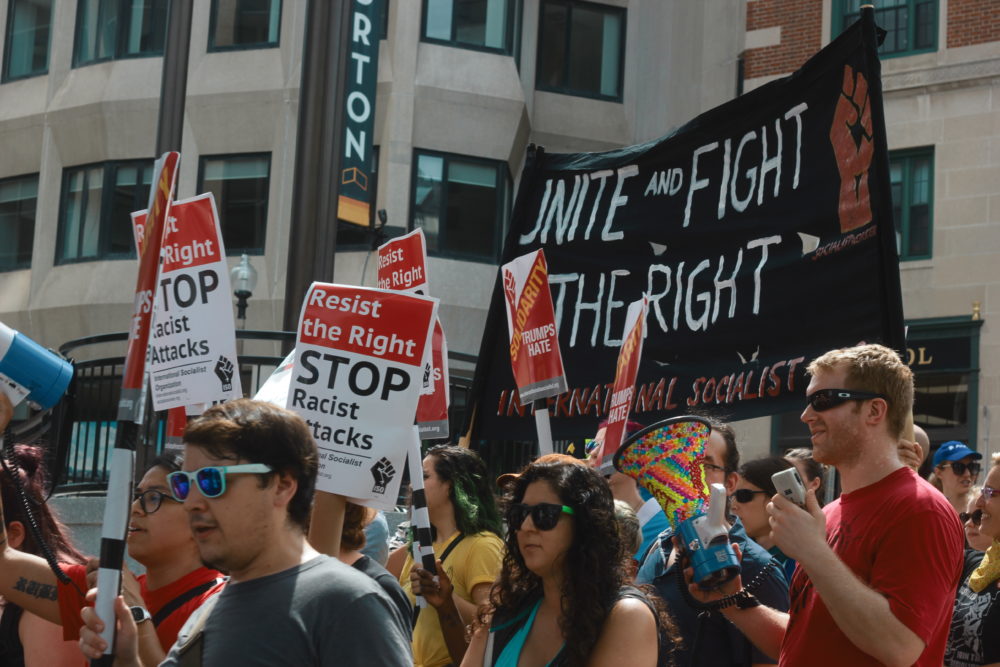
Ursula
is an administrative worker and Boston DSA member living in Cambridge, Massachusetts.
I had already signed up to serve as a marshal for the DSA and PSL-led rally in front of the State House before the news came from Charlottesville. The organizers of our counter-demonstration were girding themselves for low turnout and the danger that would pose for everyone who did turn up (and any gender nonconforming and Black or brown passersby). The centrist-liberal consensus was that it was best to respond to fascist street demos with icy, WASPish un-acknowledgment.
And then those fascists terrorized Charlottesville and murdered Heather Heyer. In their grief and outrage, masses of people suddenly understood the truth counter-protest organizers had been trying to get across for weeks. “Boston Free Speech” had been stripped of its plausible deniability. It was obviously a fascist rally. And now anyone who wanted to strike back against white supremacy and fascism had the chance to do so in their own city.
When I looked out across the Common from high up on a wall near the 54th Regiment Memorial (to Black soldiers who fought in the Civil War), I could not stop grinning. My skin prickled with the angry-yet-joyous feeling of thousands of people discovering, if only for an afternoon, the strength of solidarity. The police—who felt it, too and were cowed by it—were uncharacteristically phlegmatic. After most of the far right had been evacuated, I watched the crowd, unimpeded by police, chase a stray fascist into the ankle-deep Frog Pond on the Common and ring the shoreline to jeer at him and his soggy shoes.
With time, even the euphoria of that moment faded. The massive, highly effective turnout did not translate into continued mass participation in anti-fascist counter-protests. It is hard not to feel a little bitter when I compare August 19, 2017 to August 31, 2019, the day we countered a “Straight Pride” parade organized by some of the same local fascists. Though the turnout by largely LGBTA+ counter-protesters was considerable, lacking the sheer overwhelming strength in numbers of two years before left us vulnerable to police brutality.
I could cynically argue that this difference in turnout, and therefore outcome, was largely because most people who showed up in 2017 did so for primarily expressive reasons. They felt freshly angry and horrified, and our counter-protest was a well-time cathartic outlet. The strategic purpose of mass protest as a demonstration of the collective strength that backs up political demands—in other words, as an implied threat of direct action—is often beside the point. In contrast, leftist organizers must learn that the feeling of winning is not the same as the win itself, and chasing that feeling is not the same as doing effective work.
But as we also saw on August 19, 2017, outrage at injustice and the joy of victory through solidarity can power us forward to real, substantive political victories by inspiring new comrades to join us. The trick is to weave the memory of the spectacular, evanescent solidarity of days like that one into a deeper, sustaining solidarity that binds us together in mutual trust. It is those bonds that pull us together to fight for one another in the long struggle ahead.
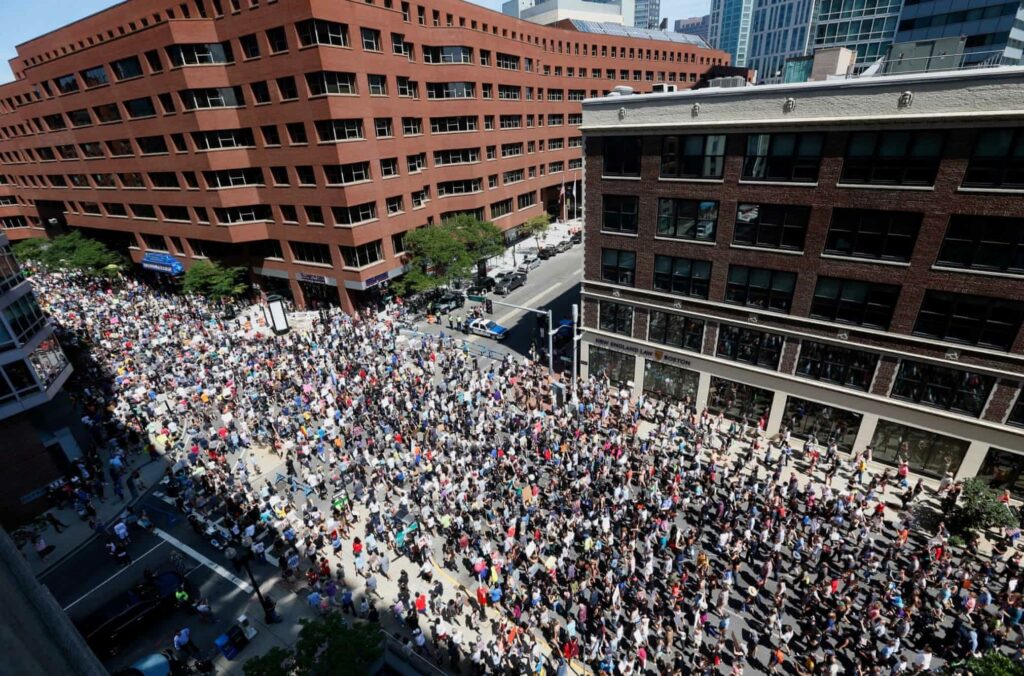
Statement from Facebook event page:
SATURDAY, AUGUST 19, 2017 AT 10 AM EDT – 5:30 PM EDT
Fight Supremacy! Boston Counter-Protest & Resistance Rally
Boston Common
Called by Monica Cannon-Grant, DiDi Delgado and others
FOR IMMEDIATE RELEASE – 8/15/17:
As many of you are aware, there have been conflicting reports that Saturday’s “Free Speech” rally in Boston, organized by white supremacists, has been cancelled. Several confirmed speakers for that event have publicly withdrawn due to community pressure. While Mayor Walsh, Police Commissioner Evans, senators from Massachusetts, and Boston City Council members have openly denounced the gathering of white supremacists slated for Boston Commons, privately they have also denounced the counter-demonstration being organized by Black leadership in the Metro North. It does not go unnoticed that organized resistance from our Black communities is ultimately what led to the apparent collapse of Saturday’s white supremacist rally and platform.
With that in mind, we would like to affirm that the Fight Supremacy Resistance Rally scheduled for Saturday, August 19th will continue as planned.
In recent months, strategies for Black liberation and resistance have shifted away from direct action and public protest. We understand that social movements must evolve and adapt accordingly if they are to remain effective and sustainable. Organizers of the Resistance Rally also understand that prevailing political realities have emboldened overt white supremacists to openly intimidate vulnerable communities, and subject them to unchecked fragility and hatred. The current administration has undeniably been complicit in willfully and deliberately inciting physical and rhetorical violence perpetrated by their neo-conservative base. We believe those committed to anti-racism work have a moral obligation to unapologetically confront and oppose these violent and threatening displays when they occur. We are pleased that community mobilization has disrupted the most recent display planned in Boston.
However, the Resistance Rally was also organized in response to all prevailing manifestations of white supremacy impacting the most marginalized. The events in Charlottesville this past week serve as glaring reminders of the blatant bigotry we still face today. While it is our intention to send a message to those who would subject marginalized communities to domestic white terrorism, hate speech, and violence, we also stand in opposition to the most insidious and deadly forms of white supremacy. These include, but are not limited to: mass incarceration, income inequality, anti-immigration initiatives, police and local law enforcement, and housing and employment discrimination.
The individuals and institutions most effective in harming Black and Brown people do not carry torches or wear white hoods. Instead, they aggressively patrol our neighborhoods, enforce laws unequally, systematically impose poverty, and suppress the voices and needs of oppressed communities. This supremacy is upheld by all who benefit from it, and is in alignment with capitalism, cis-hetero patriarchy, ableism, queer and trans antagonism, misogynoir, and all existing forms of oppression.
We envision a future where Black and Brown families are no longer torn apart due to systemic white supremacy. When Massachusetts Governor, Charlie Baker, cut funding for HIV programs, drug treatment facilities, and elder care services from the fiscal budget, it was understood that Black communities would be hit hardest. This year, 49 Boston public schools sustained significant budget cuts predominantly impacting children of color. Meanwhile, state judiciary and law enforcement institutions continue to aggressively spend resources to disproportionately profile, prosecute, and incarcerate Black community members. Black residents in Massachusetts are incarcerated at a rate SIX TIMES higher than their white counterparts.
In 2011, the state’s largest prison—MCI Norfolk—was fined thousands of dollars by the Department of Environmental Protection for failing to meet water supply standards. Water samples at MCI Norfolk showed elevated levels of minerals that, when ingested over prolonged periods of time, can lead to neurological disorders and other severe health issues. The Massachusetts Department of Corrections was ordered to install a new water treatment system. Six years later, and MCI Norfolk has not yet replaced the water system. The longstanding impact this will have on the Black community is incalculable.
Finally, access to affordable housing must be regarded as a social imperative in the Metro North. Recently, Mayor Walsh of Boston approved 720 new housing units in the neighborhood of Roxbury, with only 15% being made affordable to households earning $60-$70,000 a year. That initiative was touted as “progress,” despite a $30,000 median income for Black and Brown families currently residing in Roxbury. And according to the Boston Federal Reserve, the median net worth of white households in Boston stands at $247,000—compared to just $8.00 (yes, eight dollars) for Black households, and $28.60 for Latinx households.
This is white supremacy.
Saturday’s rally will stand in defiance of these abuses and amplify the voices and truths of the most marginalized. It will serve as an opportunity for local communities to reassert our collective power and autonomy, and reaffirm our commitment to rejecting proponents of bigotry and their oppressive narratives. Organizers of the Resistance Rally remain in solidarity with Charlottesville, Flint, Ferguson, Baltimore, Charleston, Standing Rock, Palestine, and communities of color across the globe.
We encourage individuals intent on combating white supremacy to be deliberate and purposeful in supporting those who are most affected. This means following the direction of Black and Indigenous leadership—including and especially Black queer and femme leadership. We demand to see wage increases and a redistribution of resources so Black families can escape systemic and generational cycles of poverty. We call on those striving to be allies to redistribute resources and pay reparations to Black community members and organizers in your respective communities.
Space must be created and privilege relinquished so the needs of marginalized communities can be better assessed and conveyed. If you do not know where resources are needed, reach out to Black led organizations in your area. Lastly, consider donating to Black/femme led organizations like The Marsha P. Johnson Institute, Brooklyn Community Bail Fund, Safety Pin Box, and The Charlottesville Relief Fund (www.solidaritycville.com). You can also donate to the organizers of this rally by visiting www.FightSupremacy.org.
To those attending Saturday’s rally, we look forward to your energy and presence, and remain committed to extending and advancing our organizing efforts throughout Boston and beyond.
“We believe that we will win.”
Sincerely,
Black Lives Matter Network
Violence In Boston
Angie Camacho
Black Lives Matter Boston
Black Lives Matter Cambridge
The Movement for Black Lives
#FightSupremacy #BostonResist #BlackLivesMatter #BlackTransLivesMatter
Additional reading about and photos from the August 19, 2017 counter-protest against the far right in Boston:
- “We Came, We Saw, We Covered (A #Fightsupremacy Composite Retrospect),” DigBoston, August 23, 2017.
- Leslie Savan, “Keep the Blame Where It Belongs,” The Nation, August 18, 2017.
- Chris Faraone, “Boston Counter-Protesters Aim To ‘Make White Supremacists Hide Again,’” The UpTake, August 19, 2017.
- Ryan Gannon, “The right’s hate won’t go unopposed in Boston,” Socialist Worker, August 19, 2017.
- McKay Coppins, “The Far Right’s Day in Boston,” The Atlantic, August 19, 2017.
- Keeanga-Yamahtta Taylor, “No more Charlottesvilles,” Jacobin, August 14, 2017.
- Ryan Roche, “How Boston turned the tide on the far right,” Socialist Worker, August 21, 2017.
- Travis Andersen, “BPD wants cooperation from college students ahead of rally,” Boston Globe, August 17, 2017.
- Chas Danner, “Tens of Thousands March Against Hatred and White Supremacy in Boston, Overwhelm ‘Free Speech’ Rally,” New York Magazine, August 19, 2017.
- Travis Anderson, “Speaker list for ‘free speech’ rally includes right-wing extremists,” Boston Globe, August 17, 2017.
- Jennifer Levitz and Jon Kamp, “Right-Wing Rally Overwhelmed by Counterprotesters in Boston,” Wall Street Journal, August 19, 2017.
- Michael Fiorentino, “The Racists Won’t Go Unopposed in Boston,” June 12, 2018.
- Katharine Q. Seelye, Alan Blinder and Jess Bidgood, “Protesters Flood Streets, and Trump Offers a Measure of Praise,” New York Times, August 18, 2017.
- “Free speech rally and counter protest,” Boston Globe, August 19, 2017.
- Scott Neuman, “Boston Right-Wing ‘Free Speech’ Rally Dwarfed by Counterprotesters” (“The Two-Way”),” NPR, August 19, 2017.
- Seth Millstein, “Black Lives Matter Will Be At The Boston Free Speech Rally—To Counter-Protest,” Bustle, August 18, 2017.
- Sarah Betancourt, “Trump attacks Boston counter-protesters as ‘anti-police agitators,’”The Guardian, August 19, 2017.
- Globe Staff, “Tens of thousands march for unity, overwhelming ‘free speech’ rally,” Boston Globe, August 19, 2017.
- “Rightwing rally and counter-protest in Boston—in pictures,” The Guardian (Associated Press), August 19, 2017.
- Jule Pattison-Gordon, “Tens of thousands pour into Boston streets to decry hate,” The Bay State Banner, August 23, 2017.
- Emily Sweeney, “Counterprotest organizers expect thousands to march from Roxbury to Boston Common,” Boston Globe, August 18, 2017.
- Mark Arsenault, “In a city with fraught racial past, a day or protest against hatred and bigotry,” Boston Globe, August 19, 2017.
- “Boston Free Speech Rally,” Wikipedia (photo gallery)

